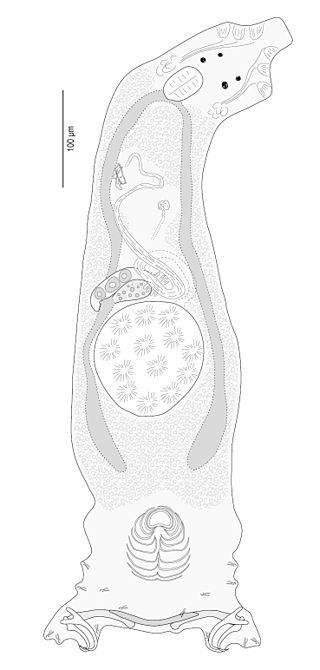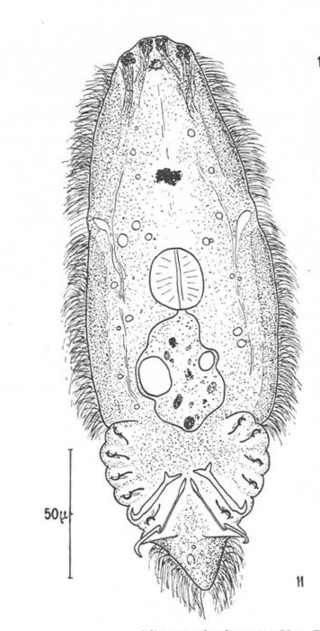Related Research Articles

Microcotyle is a genus which belongs to the phylum Platyhelminthes and class Monogenea. Species of Microcotyle are ectoparasites that affect their host by attaching themselves as larvae on the gills of the fish and grow into adult stage. This larval stage is called oncomiracidium, and is characterized as free swimming and ciliated.

Snake blenny is a fish species in the family Ophidiidae. It is widespread in the eastern Atlantic from southern England to Senegal in West Africa, and the northern Mediterranean. It is a marine subtropical demersal fish, up to 25 centimetres (9.8 in) long.

Cichlidogyrus is a genus of monopisthocotylean monogeneans in the family Ancyrocephalidae. The type-species of the genus is Cichlidogyrus arthracanthusPaperna, 1960, by original designation. All the species of the genus are parasites on the gills of fish, namely African Cichlidae, Nandidae and Cyprinodontidae.
Protocotyle euzetmaillardi is a species of monogenean of the family Hexabothriidae.

The Diplectanidae are a family of monopisthocotylean monogeneans. They are all parasitic on the gills of fish. Diplectanids are small animals, generally around 1 mm in length. As parasites, they can be extremely numerous, up to several thousand on an individual fish.

Louis Euzet was a French parasitologist.
Hexabothriidae is a family of monogenean parasites. The family name was proposed by Emmett W. Price in 1942. The family includes 14-16 genera according to authors and about 60 species; all are parasitic on the gills of chondrichthyan fishes.

Lamellodiscus is a genus of monopisthocotylean monogeneans in the family Diplectanidae; all species of Lamellodiscus are small worms, parasitic on the gills of teleost fish.

Microcotylidae is a family of polyopisthocotylean monogeneans. All the species in this family are parasitic on fish.
Plectanocotylidae is a family of polyopisthocotylean monogeneans. All the species in this family are parasitic on the gills of marine fish.

An oncomiracidium is the ciliated and free-living larva of a monogenean, a type of parasitic flatworm commonly found on fish. It is similar to the miracidium of Trematoda, but has sclerotised (hardened) hooklets not found in the latter.

Microcotyle donavini is a species of monogenean, parasitic on the gills of a marine fish. It belongs to the family Microcotylidae.
Pseudolamellodiscus is a genus of monopisthocotylean monogeneans in the family Diplectanidae. Species of Pseudolamellodiscus are parasites on the gills of marine perciform fish.
Microcotyle erythrini is a species of monogenean, parasitic on the gills of a marine fish. It belongs to the family Microcotylidae. This species was described by Van Beneden & Hesse in 1863 and redescribed by Parona & Perugia in 1890.

Microcotyle sebastis is a species of monogenean, parasitic on the gills of a marine fish. It belongs to the family Microcotylidae.

Microcotylinae is a subfamily within family Microcotylidae and class Monogenea. This subfamily was created by Taschenberg in 1879.
Bivagina is a genus of monogeneans. As all Monogenea, species in the genus are ectoparasites that affect their host by attaching themselves as larvae on the gills of fish and grow into adult stage. This larval stage is called oncomiracidium, and is characterized as free swimming and ciliated.
Caballeraxine is a genus which belongs to the family Microcotylidae and class Monogenea. As all Monogenea, species of Caballeraxine are ectoparasites that affect their host by attaching themselves as larvae on the gills of the fish and grow into adult stage. This larval stage is called oncomiracidium, and is characterized as free swimming and ciliated.
Diplostamenides is a genus which belongs to the family Microcotylidae and class Monogenea. As all Monogenea, species of Atriostella are ectoparasites that affect their host by attaching themselves as larvae on the gills of the fish and grow into adult stage. This larval stage is called oncomiracidium, and is characterized as free swimming and ciliated.
References
- ↑ Maillard, C., & Noisy, D. (1979). Atrispinum acarne ngn sp.(Monogenea, Microcotylidae) parasite de Pagellus acarne (Teleostei) du golfe du lion. Vie et milieu, 28(29), 4.
- ↑ WoRMS (2019). Atriasterinae Maillard & Noisy, 1979. Accessed at: http://www.marinespecies.org/aphia.php?p=taxdetails&id=1307056 on 2019-11-26
- ↑ Maillard, Cl.; Euzet, L.; Silan, P. (1988). "Création du genre Serranicotyle (Monogenea, Microcotylidae): Serranicotyle labracis (Van Beneden et Hesse, 1863) n. comb., ectoparasite de Dicentrarchus labrax (Teleostei)". Annales de Parasitologie Humaine et Comparée. 63 (1): 33–36. doi: 10.1051/parasite/198863133 .
